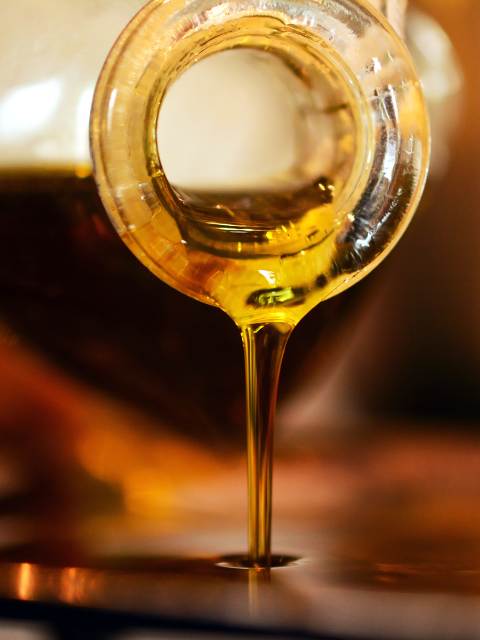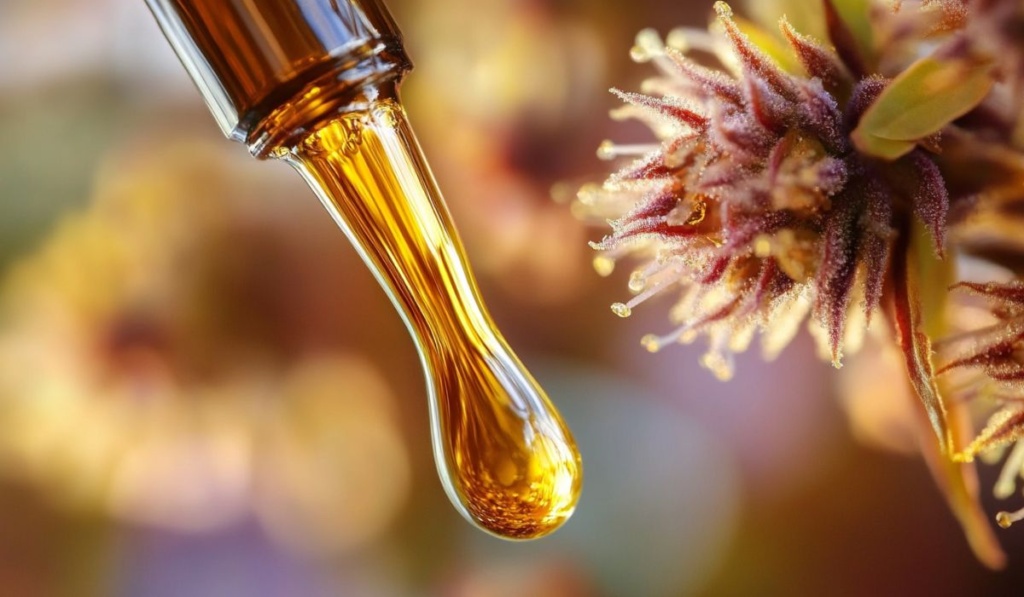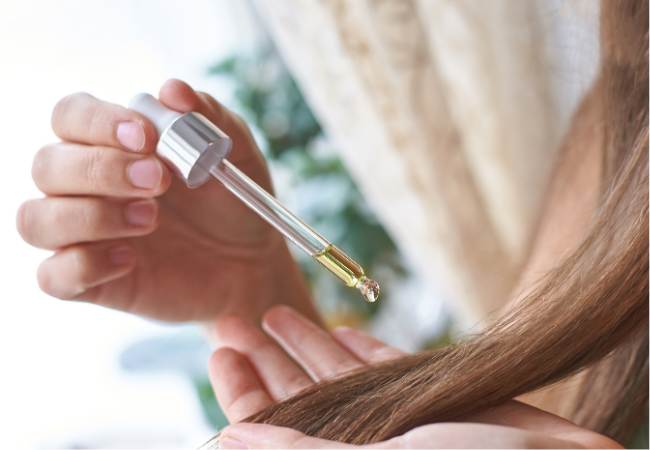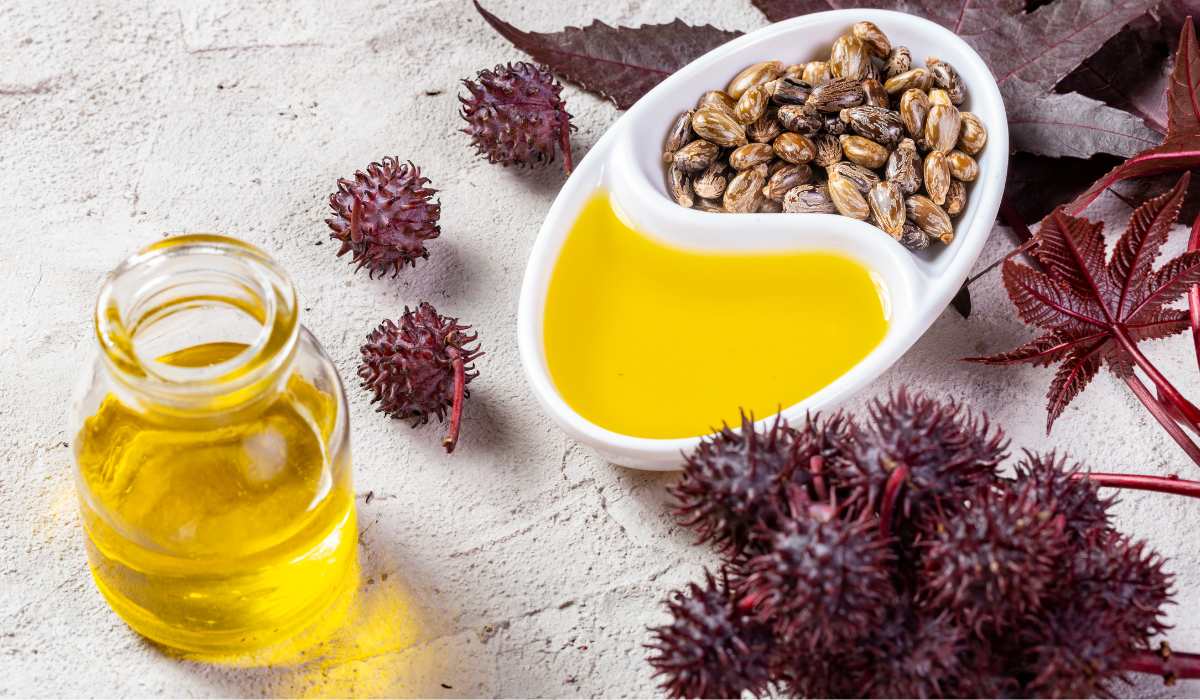Castor Oil on Face Overnight: What Happens, What to Avoid & Best Tips
Can You Use Castor Oil on Your Face Overnight? Yes, But Only If You Do This First
Let’s talk about castor oil.
I’ve been formulating with it for years. You’ll find it in all my lip balms (mainly because it adds that gorgeous glossy shine) but also because it’s brilliant at locking in moisture.
If you’ve ever swiped on a balm that made your lips feel softer and look better, there’s a good chance castor oil was behind it. Yeh.

I’ve also used it in facial oils and serums, especially for dry, dull or mature skin. It’s thick, yes… But that thickness comes with a payoff: deep nourishment, long-lasting hydration, and a subtle PLUMPING effect that’s hard to ignore.
So it makes sense that people are curious about it. Especially the whole “can I sleep with castor oil on my face?” question.
I hear you.
You’re probably wondering:
“Can I put castor oil on my face overnight?”
“Is it safe around the eyes?”
“Will it help with wrinkles?”
“Why do some people say it clogs pores?”
“What does castor oil actually do for skin?”
etc
etc
There’s also the classic internet problem: too much information, not enough clarity.
One Tik Tok video says it’s a miracle cure. Another Facebook post says it’ll ruin your skin barrier. It’s no wonder people feel overwhelmed.
So if you’ve been googling “castor oil for face” and ended up more confused than when you started… I’m afraid this guide is for you.
We’re going to cover:
- What castor oil does for skin (and what it doesn’t)
- How to safely use it overnight (yes, there’s a right way)
- Who it works for (and who should skip it)
- How to blend it into your moisturiser, make your own mask, and avoid the common mistakes that lead to breakouts
- Why it’s different from other oils (and what makes it one of the best for certain skin types)
- Bonus: how castor oil compares for skin vs hair, and why one bottle won’t work for both
If you’ve been wondering whether castor oil deserves a spot in your skincare routine (or if it’s best left to your eyebrows) keep reading.
This is the no-fluff, no-fear guide you’ve been looking for.
Ready?
Disclaimer: I link to affiliate products below. If you purchase through my links I might earn a commission at no extra cost to you.
What does castor oil do for skin? (More than you might think)
Let’s start with the basics.
Castor oil is thick. Really thick. Almost sticky.

So when people first hear about using it on their face, especially overnight, the initial reaction is usually: “Won’t that clog everything?”
Not necessarily.
Castor oil is rich in ricinoleic acid, a rare fatty acid that makes up about 90% of the oil.
That’s what gives it its signature texture, and A LOT of its skincare power.
Here’s what it actually does when applied to skin:
1. Deep hydration without the greasy feel (once it settles in)
Despite how dense it looks and feels, castor oil acts more like an occlusive (meaning it helps trap moisture in your skin), rather than just sitting there.
If your skin is already dry or dehydrated, this barrier can help it stay soft and plump longer.
2. Supports skin barrier repair
If your skin’s been flaky, tight or just plain grumpy lately, castor oil can help support its natural repair process.
It’s NOT a miracle worker, but it can help reduce moisture loss and soothe irritation if used properly.
3. A potential helper for wrinkles and fine lines
No oil erases wrinkles.
But if your skin is dry, fine lines can look more obvious.
Castor oil helps by softening the skin and making everything appear a bit smoother.
Over time, keeping the skin well-moisturised can help support skin elasticity.
4. Antimicrobial properties (with limits)
Castor oil has shown mild antimicrobial effects in lab settings, which is why it’s sometimes recommended for spot-treating small blemishes.
That said, if you’re acne-prone or already using actives, tread CAREFULLY. The texture alone can be too heavy for some people. Always patch test.
HOW TO PATCH TEST: To patch test castor oil, apply a small amount (about a drop) to a discreet area of clean, dry skin such as the inside of your elbow or behind your ear. Leave it on without washing for 24 hours. If you notice any redness, itching, swelling, or irritation during that time, rinse it off and avoid using the oil. If there’s no reaction, it’s generally safe to use.
5. Possibly calming for redness and reactive skin
It’s not a universal fix, but many people with redness or mild irritation find castor oil soothing.
It won’t replace your serum or your barrier-repair cream, but it can be a nice addition to your night time routine, especially in winter.
6. A note on glow
Because of its density and shine, castor oil gives the skin a subtle glossy finish after application.
Not shimmer, I mean just glow.
It can make your face look fresher and healthier almost instantly, which is why I like adding a drop to moisturiser even when I’m not using it overnight.
Can I put castor oil on my face overnight? What to know first

Short answer: yes.
Slightly longer answer: yes, but please don’t slather it on like it’s a hair mask.
Leaving castor oil on your face overnight can be wonderful for certain skin types, especially if you’re dealing with dryness, dullness, or a weak skin barrier.
But if you get breakouts easily, or if your skin’s more combo than dry, it’s not always the dream it’s made out to be online.
So, who shouldn’t use castor oil overnight?
If any of this sounds like you, be cautious:
- You’re acne-prone or get clogged pores easily
- Your skin hates heavier oils (like coconut or wheatgerm)
- You already use strong actives (retinol, AHAs, etc.)
- Your face has a history of reacting to products for no clear reason
This doesn’t mean you can’t ever use it.
Just maybe don’t go straight to “full face overnight” on a Monday.
Patch testing is non-negotiable
Before doing anything else, dab a tiny bit on your neck or jawline.
Leave it overnight. Wait 24–48 hours.
If you wake up red, itchy, or angry-faced, castor oil isn’t your friend. If not? You’re likely good to go.
A little goes a long way (I mean it)
One drop.
Maybe two if your skin’s Sahara-level dry. That’s it.
This isn’t the kind of oil you massage into your skin for five minutes like you’re in a spa.
Press it in gently, or mix it into your moisturiser so it’s more evenly spread out.
Frequency matters
Even if your skin loves it, don’t overdo it.
Start with once a week. If that goes well, try two.
You don’t need to commit to every night to see results—sometimes, less is more.
How to use castor oil on your face overnight (without waking up regretting it)
So you’ve patch tested. Your skin’s not freaking out.
And you’re ready to give this whole “castor oil on face overnight” thing a go. Good.
But let’s not overcomplicate it. This is how you do it without turning your pillow into an oil slick or waking up to a breakout.
Step 1: Cleanse your face (properly)
You need a clean base. Think gentle but thorough.
No need for harsh scrubs or exfoliators—just get rid of makeup, SPF, and anything else hanging around from the day.
Balm cleanser, cream cleanser, micellar water… Whatever your skin likes.
Step 2: (Optional) Use a hydrating toner or mist
Not essential, but helpful.
Applying castor oil over slightly damp skin can help trap more hydration.
Just skip this step if you’re using an exfoliating toner as it’s not a great combo.
Step 3: Add castor oil to your moisturiser (or apply it straight)
This depends entirely on how you like it.
You’ve got two solid options:
1. Mix 1 drop into your moisturiser
This is the easiest, gentlest way to start. It thins out the oil a bit and makes it easier to apply evenly.
2. Use it solo (sparingly)
If you’re going straight-up castor oil, warm 1 drop between your fingers and gently press it into your skin. Not rub. Not smear. Press. You can always build up next time if it goes well.
Either way, avoid the eye area unless you’ve tested it there and your skin doesn’t react.
Step 4: Go to bed
That’s it.
There’s no magic ritual or 10-minute massage.
Just go to sleep and let the oil do its thing.
Expect your skin to feel a bit tacky, yes, that’s normal.
Step 5: Rinse off in the morning
Use warm (not hot) water and a soft cloth if needed.
Follow with your usual routine.
If your skin feels great, you’re good to repeat in a few days.
If not? No big deal. Just pull back or try it a different way.

When to expect results from using castor oil on your face overnight
Let’s be honest: castor oil isn’t Botox (and thank Goddess).
But if your skin likes it, you can expect to notice subtle changes surprisingly quickly.
And, no, it’s not going to erase wrinkles overnight or magically transform your skin after one use. But remember: wrinkles are part of who we are and what happens over time. They define our personality as well. No wrinkles means no experience! I write for natural health and beauty, not not to feed some impossible standard of youth designed to please others in a patriarchal society.
After one night…
- Your skin may feel softer and more supple
- Dry patches can look less flaky
- You might notice a slight glow or sheen (thanks to that occlusive barrier)
It’s not dramatic, but your skin can feel calmer, more nourished, and just better.
After a week (using 1–2 times)
- Dehydrated areas may stay moisturised for longer
- Skin tone can look a little more even
- Under-makeup texture might improve (especially if your skin’s been rough or tight) – also contemplate never wearing make up again… can you do that? Much healthier emotionally and physically!
After a month (with regular use)
- Fine lines might appear slightly less noticeable
- Your skin’s natural moisture barrier can feel stronger
- You may find your skin needs less product during the day to stay hydrated
But, if your skin hasn’t improved after 2 or 3 uses, or starts breaking out, it’s probably not a match.
Castor oil isn’t universal. Better to know than to keep pushing through irritation that’s not worth it.
Common mistakes to avoid when using castor oil overnight

If castor oil didn’t work for you, chances are one of these happened.
These are the most common (and completely avoidable) mistakes people make when trying castor oil on their face overnight.
1. Using way too much
It’s an oil, not a moisturiser. You don’t need a teaspoon. Or a puddle. One drop. Two max. Castor oil is thick and concentrated, you only need a little to cover your whole face.
2. Applying it to dirty or damp-but-not-clean skin
Castor oil seals in what’s already on your skin. If that includes sunscreen residue, pollution, or bacteria from the day… guess what… that gets sealed in too. Disgusting.
Always cleanse first. You want to lock in hydration, not grime.
3. Mixing it with the wrong products
If you’re already using actives like retinol or exfoliating acids (AHAs, BHAs), layering thick castor oil over the top can trap them in and make irritation worse.
If you’re using those ingredients at night, skip the castor oil or simply alternate nights.
4. Going too close to the eyes without testing
Yes, some people swear by castor oil for the under-eye area. But the skin there is thinner and more sensitive.
Always patch test first (as per my above instructions) and only use a tiny amount if your skin is happy with it.
If your eyes feel puffy, itchy or heavy in the morning, it’s a NO-NO.
5. Doing it every single night
More isn’t always better.
Even if your skin loves castor oil, using it overnight every single night can be too much.
Think of it like a treatment and not your everyday moisturiser.
Once or twice a week is usually plenty, trust me.
Castor oil face mask recipe (for dry or mature skin)
If you’re not ready to leave castor oil on your face overnight—or just want something a little more “spa moment”, a quick DIY face mask is a great way to try it.
This one is especially good for dry, dull, or mature skin. It hydrates, softens, and gives you that smoother-skin feel without the overnight commitment.
A fantastic DIY soothing castor oil face mask
You’ll need:
- 1 teaspoon aloe vera gel (store-bought is fine, as long as it’s pure and preserved). Here I help you choose your aloe vera gel so you don’t buy the wrong one. If you have no time to learn, THIS IS THE ONE I RECOMMEND.
- 3 drops castor oil
- 1–2 drops lavender or frankincense essential oil (optional, but nice)
How to use:
- Mix everything together in a small clean bowl.
- Apply a thin layer to clean skin.
- Leave it on for 10 or 15 minutes.
- Rinse with warm water, then pat dry.
Follow with your usual moisturiser or facial oil…
How often?
Once a week is plenty. It’s more of a “reset” than a daily thing—and it gives you a chance to see how your skin reacts to castor oil without leaving it on all night.
Other ways to use castor oil for skin care (if overnight isn’t for you)
Not everyone wants to sleep with oil on their face, and honestly, that’s fair. I don’t mind it but other people don’t like it at all.
Still, you might want to make the most of your newly purchased castor oil dropper bottle!.
If the idea of waking up with a sticky pillow isn’t your thing, there are still plenty of ways to get the benefits of castor oil without leaving it on overnight.
Here are a few no fuss options to try:
1. Add a drop to your moisturiser
Mentioned before above a few times but I really want you to understand that this is such a good idea and it works for almost everyone.
So, yes, this is the easiest way to start. Just one drop mixed into your usual moisturiser makes it a little richer, adds gloss, and helps lock in hydration.
Use it at night.
2. Use it as a spot treatment for dry patches
Warm a drop between your fingers and press it into just the dry areas (around nose, forehead, etc). No need to oil your whole face.
3. Press a tiny amount under the eyes (with caution)
If you’ve patch tested (instructions above) and your skin’s fine with it, castor oil can feel lovely under the eyes.
Use the tiniest amount (seriously, half a drop!!) press it in gently with your ring finger, and see how it goes.
It is especially nice in winter when everything feels tighter and more delicate.
4. Try it as a simple facial oil cleanser
At night, massage a few drops into dry skin, then wipe off with a warm damp cloth.
It lifts grime without stripping your skin and you’re not leaving it on, so even oilier types might get on with it.
Can I use the same castor oil on my hair?

Technically? Yes.
Practically? You probably shouldn’t.
Castor oil is a multitasker, it’s used for both skin and hair. But if you’re dipping into the same bottle for your scalp and your face, you’re playing skincare roulette. Hair and scalp tend to carry more bacteria, styling product residue, and general gunk.
The last thing you want is to introduce any of that into your skincare routine.
If you’re going to use castor oil for hair too, here’s how to do it:
- Keep two bottles: One for face, one for hair. Label them if you have to.
- Use clean tools: Don’t double dip with fingers that just massaged your scalp.
- Go for pure, cold-pressed, hexane-free castor oil for both, but especially for your skin. HERE’S MY RECOMMENDED CASTOR OIL.
For hair, castor oil can be great for:
- Conditioning dry ends
- Soothing the scalp
- Supporting growth along the hairline or brows
Just don’t cross-contaminate.
Is castor oil the best option for overnight skin care?
For the right skin? It can be brilliant.
For the wrong skin is a quick way to clog things up and wonder why your face suddenly hates you.
Castor oil is thick, slow absorbing, and not designed to feel light and fluffy.
But that’s kind of the point. If your skin is dry, flaky, sensitive, or just generally tired of losing moisture overnight, castor oil can help seal everything in and give your face time to recover.
It’s especially good in cold weather, dry climates, or when your skin barrier needs a little extra support.
But let’s be clear: it’s not a miracle oil like many proclaim.
It’s not going to erase wrinkles or fix everything overnight.
And it’s absolutely not for everyone.
If your skin tends to break out, gets congested easily, or already has a lot going on (retinol, acids, etc.), castor oil might be too much.
By the way, you might be interested in my other articles on castor oil:
Final verdict?
Castor oil can be a great option for dry, mature, or sensitive skin that needs a bit of extra nourishment and protection overnight.
It’s not ideal if you’re acne-prone, oily, or using strong actives like retinol or acids, as its thick texture can be too much.
For most skin types, it’s best used just once or twice a week with a very light hand, definitely not something to slather on daily.
It’s worth trying if you’re curious, but only if you’re willing to patch test first and listen to how your skin responds!
If you’ve been wondering whether castor oil deserves a place in your skin care routine, I hope this helped clear up the noise.
Patri xx
Research
1. Alookaran J, Tripp J. Castor Oil. In: StatPearls [Internet]. Treasure Island (FL): StatPearls Publishing; 2025 [cited 2025 Feb 11]. Available from: http://www.ncbi.nlm.nih.gov/books/NBK551626/.
2. Alookaran J, Tripp J. Castor Oil. In: StatPearls [Internet]. Treasure Island (FL): StatPearls Publishing; 2025 [cited 2025 Feb 11]. Available from: http://www.ncbi.nlm.nih.gov/books/NBK551626/.
3. Ogunniyi DS. Castor oil: A vital industrial raw material. Bioresource Technology [Internet]. 2006 [cited 2025 Feb 11]; 97(9):1086–91. Available from: https://www.sciencedirect.com/science/article/pii/S0960852405002026.
4. Patel VR, Dumancas GG, Viswanath LCK, Maples R, Subong BJJ. Castor Oil: Properties, Uses, and Optimization of Processing Parameters in Commercial Production. Lipid Insights [Internet]. 2016 [cited 2025 Feb 11]; 9:LPI.S40233. Available from: https://journals.sagepub.com/doi/10.4137/LPI.S40233.
5. Castor Oil – an overview | ScienceDirect Topics [Internet]. [cited 2025 Feb 11]. Available from: https://www.sciencedirect.com/topics/nursing-and-health-professions/castor-oil.

